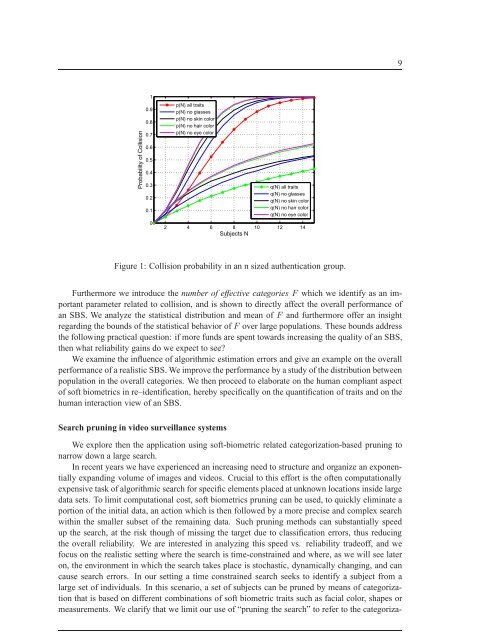FACIAL SOFT BIOMETRICS - Library of Ph.D. Theses | EURASIP
FACIAL SOFT BIOMETRICS - Library of Ph.D. Theses | EURASIP
FACIAL SOFT BIOMETRICS - Library of Ph.D. Theses | EURASIP
You also want an ePaper? Increase the reach of your titles
YUMPU automatically turns print PDFs into web optimized ePapers that Google loves.
9Probability <strong>of</strong> Collision10.90.80.70.60.50.40.30.20.10p(N) all traitsp(N) no glassesp(N) no skin colorp(N) no hair colorp(N) no eye colorq(N) all traitsq(N) no glassesq(N) no skin colorq(N) no hair colorq(N) no eye color2 4 6 8 10 12 14Subjects NFigure 1: Collision probability in an n sized authentication group.Furthermore we introduce the number <strong>of</strong> effective categories F which we identify as an importantparameter related to collision, and is shown to directly affect the overall performance <strong>of</strong>an SBS. We analyze the statistical distribution and mean <strong>of</strong> F and furthermore <strong>of</strong>fer an insightregarding the bounds <strong>of</strong> the statistical behavior <strong>of</strong>F over large populations. These bounds addressthe following practical question: if more funds are spent towards increasing the quality <strong>of</strong> an SBS,then what reliability gains do we expect to see?We examine the influence <strong>of</strong> algorithmic estimation errors and give an example on the overallperformance <strong>of</strong> a realistic SBS. We improve the performance by a study <strong>of</strong> the distribution betweenpopulation in the overall categories. We then proceed to elaborate on the human compliant aspect<strong>of</strong> s<strong>of</strong>t biometrics in re–identification, hereby specifically on the quantification <strong>of</strong> traits and on thehuman interaction view <strong>of</strong> an SBS.Search pruning in video surveillance systemsWe explore then the application using s<strong>of</strong>t-biometric related categorization-based pruning tonarrow down a large search.In recent years we have experienced an increasing need to structure and organize an exponentiallyexpanding volume <strong>of</strong> images and videos. Crucial to this effort is the <strong>of</strong>ten computationallyexpensive task <strong>of</strong> algorithmic search for specific elements placed at unknown locations inside largedata sets. To limit computational cost, s<strong>of</strong>t biometrics pruning can be used, to quickly eliminate aportion <strong>of</strong> the initial data, an action which is then followed by a more precise and complex searchwithin the smaller subset <strong>of</strong> the remaining data. Such pruning methods can substantially speedup the search, at the risk though <strong>of</strong> missing the target due to classification errors, thus reducingthe overall reliability. We are interested in analyzing this speed vs. reliability trade<strong>of</strong>f, and wefocus on the realistic setting where the search is time-constrained and where, as we will see lateron, the environment in which the search takes place is stochastic, dynamically changing, and cancause search errors. In our setting a time constrained search seeks to identify a subject from alarge set <strong>of</strong> individuals. In this scenario, a set <strong>of</strong> subjects can be pruned by means <strong>of</strong> categorizationthat is based on different combinations <strong>of</strong> s<strong>of</strong>t biometric traits such as facial color, shapes ormeasurements. We clarify that we limit our use <strong>of</strong> “pruning the search” to refer to the categoriza-
















